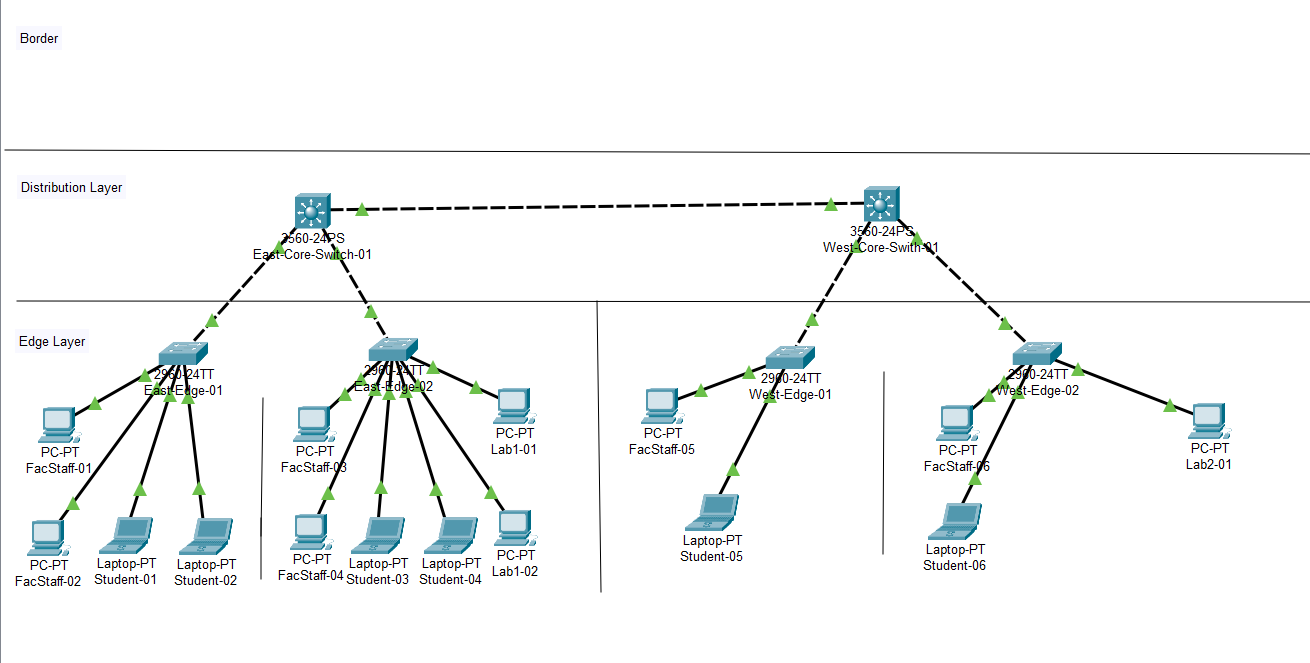Net330 Lab2.1 - Zacham17/my-tech-journal GitHub Wiki
Subnet Design Lab
In this lab, I planned and designed a network simulated for a school in Packet Tracer. The network that I started with was 10.26.0.0/16, and I split that network into different subnets.
Subnet Table
The table below shows the different VLANs that I configured in this lab and information regarding each subnet.
| VLAN | VLAN_NAME | Hosts Needed | Network | Netmask | CIDR | Router Address | Last Usable |
|---|---|---|---|---|---|---|---|
| 200 | StuWireless | 900 | 10.26.0.0 | 255.255.252.0 | /22 | 10.26.0.1 | 10.26.3.254 |
| 210 | FSWireless | 650 | 10.26.4.0 | 255.255.252.0 | /22 | 10.26.4.1 | 10.26.7.254 |
| 110 | Student | 450 | 10.26.8.0 | 255.255.254.0 | /23 | 10.26.8.1 | 10.26.9.254 |
| 1 | Management | 250 | 10.26.10.0 | 255.255.255.0 | /24 | 10.26.10.1 | 10.26.10.254 |
| 100 | FacStaff | 200 | 10.26.11.0 | 255.255.255.0 | /24 | 10.26.11.1 | 10.26.11.254 |
| 130 | StuLab1 | 35 | 10.26.12.0 | 255.255.255.192 | /26 | 10.26.12.1 | 10.26.12.62 |
| 140 | StuLab2 | 35 | 10.26.12.64 | 255.255.255.192 | /26 | 10.26.12.65 | 10.0.12.126 |
Physical Setup in Packet Tracer.
- I used a preset packet tracer file with devices already placed for this lab.
- The setup represents two lab environments and two different classroom environments.
- Each room contains devices on different VLANs and has its own layer 2 switch.
- There are two layer 3 routing switches: One for the East and one for the West.
- After I finished logical configuration, I connected the devices with the appropriate cable.
- The screenshot below shows the finished setup
 Solid Line is Straight Through and Dotted Line is Crossover
Solid Line is Straight Through and Dotted Line is Crossover
Logical Setup in Packet Tracer
- I configured the devices shown in the packet tracer screenshot above according to the the Subnet table at the top of the page.
- On each switch, I added to the VLAN database according to the following guidelines:
- 100 and 110 to all
- 130 (Lab1) in East-02 switch only
- 140 (Lab2) in West-02 switch only
- On each switch, I assigned VLANs according to the following guidelines:
- All edge switches assigned VLAN 100 (FacStaff) on ports 4-12
- All edge switches assigned VLAN 110 (Student) on ports 13-20
- East-Edge-02 assigned VLAN 130 (Lab1) on ports 21-24
- West-Edge-02 assigned VLAN 140 (Lab2) on ports 21-24
- Useful commands that I used to do this are:
interface range FastEthernet 0/x-y (where x-y is the port range)
switchport access vlan x (where x is the vlan number))
- The above commands are useful for assigning VLANs to ranges of ports.
- For host machines, such as FacStaff PCs, Student Laptops, and Lab PCs, I used the first usable host addresses in their corresponding network.
Trunk Ports
- I then configured the FastEthernet 0/1 and 0/2 ports as trunk ports on the core switches in the configuration tab for each switch. I set each trunk port for the 100, 110, 130, and 140 VLANs.
- I then configured the FastEthernet 0/1 port as a trunk port on each edge switch in the configuration tab for each switch. I set each trunk port for the 100, 110, 130, and 140 VLANs
Enabling Routing
- On the East Core Switch, I configured routing according to the table, using the following commands:
(config)ip routing
(config)interface vlan 100
(config-if)ip address 10.26.11.1 255.255.255.0
(config)interface vlan 110
(config-if)ip address 10.26.8.1 255.255.254.0
(config)interface vlan 130
(config-if)ip address 10.26.12.1 255.255.255.192
(config)interface vlan 140
(config-if)ip address 10.26.11.65 255.255.255.192
The above commands set the routing address for each vlan
Cisco Console Prefix Tips
- The prefix before typing a command specifies the mode you are in.
- Ex: (config-if) means you are editing an interface2
Trunking Between East and West
- I configured the Gigabit Ethernet 0/1 port for each core switch as a trunk port and configured them for the 100, 110, 130, and 140 VLANs and connected the core switches with a crossover cable.
- After completing all these steps, I was able to ping across all devices across all VLANs.